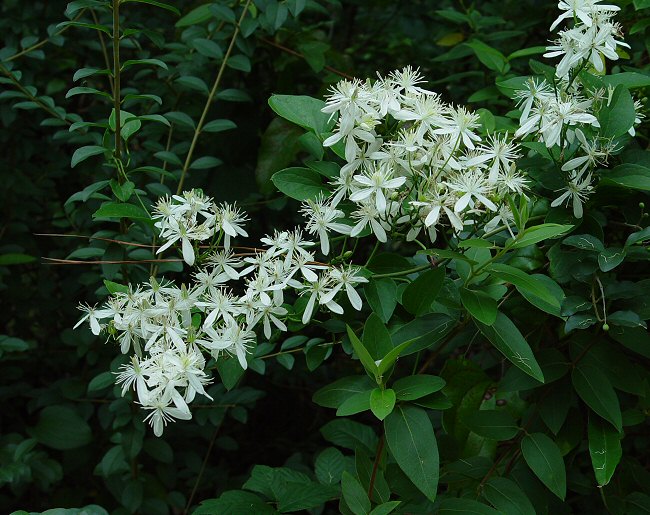Clematis terniflora DC.
Virgin's Bower

Introduced
CC = *
CW = 3
MOC = 19
© DETenaglia
Clematis terniflora DC.Virgin's Bower | |
 |
Introduced CC = * CW = 3 MOC = 19 |
© DETenaglia |
|
Family - Ranunculaceae Habit - Twining perennial forb. Stems - Twining to trailing or climbing, to 6 m, somewhat woody near base, much branched.
Leaves - Opposite, petiolate. Well-developed leaves pinnately 5-7 compound, herbaceous in texture, the minor veins not raised, the leaflets entire, to 7 cm long and 4 cm broad, mostly ovate, some cordate at the base, the upper surface green, the undersurface glabrous or very sparsely hairy along the main veins, green or pale but not glaucous. Petiolules to 3 cm long, twining.
Inflorescence - Axillary cymose panicles. Peduncles and pedicels glabrous to sparsely pubescent.
Flowers - Mostly perfect, fragrant. Perianth saucer-shaped, the sepals 9-15 mm long, spreading horizontally, white and petal-like, not thickened or leathery, the margins relatively smooth, the outer surface hairy, the inner surface glabrous. Petals absent. Stamens about 30. Filaments white, glabrous, to 8 mm long. Anthers whitish to pale yellow, to 2 mm long. Pistils 5, distinct, 8 mm long, silky-hairy.
Fruits - Achenes, flattened-ellipsoidal, to 8 mm long, with the beak 2-6 cm long, plumose with long, spreading hairs.
Flowering - August - September. Habitat - Fencerows, roadsides, railroads, gardens. Also escaped to disturbed areas, empty lots. Origin - Native to eastern Asia. Lookalikes - Clematis virginiana, Clematis catesbyana. Other info. - This beautifully showy and fragrant species is found in widely scattered locations throughout Missouri, and its U.S. distribution is similarly sporadic. It is frequently cultivated, and many occurrences in apparently wild places may represent persistence from former cultivation. It also escapes cultivation and may spread aggressively by seed in gardens. The plant may be recognized by its showy sprays of flowers with four "petals" (these are actually sepals), and its entire, unlobed leaflets. The flowers are about 3-4 cm broad and attract many beneficial flying insects. Although the plant does not have tendrils, it climbs and clambers over trellises or other vegetation by means of the leaf stalks, which twine around objects in the manner of tendrils. Photographs taken off Moore's Mill Road, Auburn, AL., 8-26-04 (DETenaglia), also near Glencoe, St. Louis County, MO, 10-31-2011, and near Labadie, Franklin County, MO, 9-4-2016 (SRTurner). |